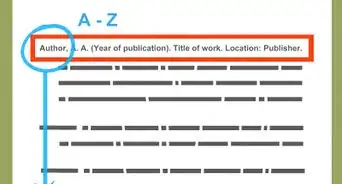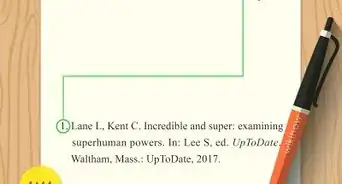This article was co-authored by Christopher Taylor, PhD. Christopher Taylor is an Adjunct Assistant Professor of English at Austin Community College in Texas. He received his PhD in English Literature and Medieval Studies from the University of Texas at Austin in 2014.
There are 8 references cited in this article, which can be found at the bottom of the page.
wikiHow marks an article as reader-approved once it receives enough positive feedback. In this case, 84% of readers who voted found the article helpful, earning it our reader-approved status.
This article has been viewed 267,109 times.
The Modern Language Association (MLA) citation style is used for journals and research papers in the humanities. When making a citation, you must include a full citation on your works cited page, as well as a shorter in-text citation where you reference information from the website. The 8th edition of the MLA Handbook focuses on you providing as much information as you can based on a set of 8 core elements: the author, the title of the source, the title of the container, other contributors, the version, the number, the publisher, the publication date, and the location; less emphasis is put on formatting than on consistency. However, you will not be able to find all this information when you're making a citation for a website, so you only put in what you can find.
Steps
Citing an Entire Website
-
1Start with the author's name. When it comes to a website, it can be difficult to find an author for the whole website. If the author isn’t clearly stated, you may be able to find one on the "About Me" page. You can also use an editor or compiler. If you can't find one, you can skip this step and begin with the next part, the website name.[1]
- When listing the name, put the last name first, followed by a comma and the first and middle names (if available).
- It should look like the following name: Roberts, Rebeca Jean.
- Put a period after the name.
- In the case of authors, you're now allowed to use a handle (such as a Twitter handle) rather than the author's name if you can't find a name, such as @felinesforthewin.
-
2Add the title of the website next. The title of the website is the main name given to the website. You'll often find it in the header of the website, at the top of every page. Normally, you'd put what MLA calls the "Title of Source" next, which refers to the smaller section where you found your information, such as the page name or a journal article in a larger journal. However, if you're using a whole website, you leave this part out and just put in the name of the website.[2]
- The name of the website should be in italics.
- It should look like the following citation: Roberts, Rebeca. Cats Who Sleep,
- Use a comma after the website title.
Advertisement -
3Include other contributors. If you find other people who contributed to the website besides the main editor, you can include it after the name of the website. Usually, you add in how the person or persons contributed, such as "edited by" for editors.
- Add contributors in using the following method: Roberts, Rebeca Jean. Cats Who Sleep, edited by John Jacobs and Joseph George,
- Put a comma after the contributors.
- If the website doesn't have other contributors, leave this part out.
Warning! Remember to indent the second line. Without an indent, it is incorrect. This is called a hanging indentation.
-
4Move on to the publisher. Normally, a version and number would come next, such as with a journal, but most websites don't have versions or numbers, so move on to the publisher. The publisher in this case is the organization or sponsor of the website. If the name of the publisher is the same as the website, you can leave off the name of the publisher.[3]
- The publisher will follow the comma after the other contributors: Roberts, Rebeca Jean. Cats Who Sleep, edited by John Jacobs and Joseph George, The Cat Institute,
- If there are no other contributors, follow the website title with the publisher: Roberts, Rebeca Jean. Cats Who Sleep, The Cat Institute,
- Follow it with a comma.
-
5Add the location. The location does not refer to the place it was published. While older editions of the MLA Handbook required the place of publication, that is not included in the 8th edition for the most part. The location, instead, refers to the place you found the information. In this case, that is the website's URL address. The URL address is what's found in your browser's address bar at the top of your computer screen.
- Don't use the "http://" or "https://" before the website. Instead, begin with "www."
- Add the website after the publisher: Roberts, Rebeca Jean. Cats Who Sleep, edited by John Jacobs and Joseph George, The Cat Institute, www.thewebsiteforsleepingcats.com.
-
6Leave out any information you can't find. In the past, when you couldn't find a piece of information, you'd need to add things like "n.d." for "no date" or "n.p." for "no publisher." However, now MLA recommends that you just leave the information out. You don't need to put anything in its place.
- You can add the date you viewed the page if you wish, but you aren't required to include it. The date goes before the location.
Citing a Page From a Website
-
1Begin with the author's name. Once again, you begin with the author's last name, then the first. In this case, you're looking for the author of the page you're citing, not the whole website. Often, the author's name will be at the top of the page or near the bottom, before the comments. If the whole site was put together by one person, you can use that person's name. Otherwise, if you can't find an author, leave it off and begin with the title of the page.[4]
- Start with the last name first, followed by the first and middle names, if applicable: Fitzgerald, Rosa.
- Use a period after the name.
- If you can't find the author's name, you can use a handle in place of the name.
-
2Add the title of the page. Next, find the title of the page you're citing. You must have a title of the page. Otherwise, you might as well be using a full website citation. The title is usually at the top of the page, under the header for the whole website.[5]
- Put the page title in quotation marks: Fitzgerald, Rosa. "The Sleeping Habits of Elderly Felines."
- Use a period before the final quotation mark.
Warning! Remember to indent the second line. Without an indent, it is incorrect. This is called a hanging indentation.
-
3Include the website name. After the page title, you need the website name, just as you did when you cited a whole website. The website name is usually found at the top of any of the website's pages, in the website's main header. If you can't find it there, look on the "About Me" page.[6]
- Put the website name in italics: Fitzgerald, Rosa. "The Sleeping Habits of Elderly Felines." Cats Who Sleep,
- Use a comma after the website name.
-
4Place other contributors next. If you find someone else who contributed to the page or who edited it, you can add that name in next. You should also add in a description of how the person contributed, such as "edited by," to indicate what the person did.
- The contributors come after the website name: Fitzgerald, Rosa. "The Sleeping Habits of Elderly Felines." Cats Who Sleep, edited by John Jacobs,
- Put a comma after the contributor.
- If you don't have other contributors, leave this part out.
-
5Note the publisher next. The publisher is the sponsor or main organization of the website. You can find it on the "About Me" page, or sometimes on the bottom of any of the website's pages. If the publisher name is the same as the website name, you don't need to include it.[7]
- Add the publisher after the contributors. If there are no other contributors, add it after the website name: Fitzgerald, Rosa. "The Sleeping Habits of Elderly Felines." Cats Who Sleep, edited by John Jacobs, The Cat Institute,
- Use a comma afterwards.
-
6Include the location. In this case, just like in the case of citing a full website, the location is the website's URL address. To find the URL address, look at the address bar at the top of your browser. It should begin with "http://", "https://" or "www." Copy and paste it into your citation, except always leave off the "http://" or "https://" and begin with "www."[8]
- Place the website's URL after the publisher: Fitzgerald, Rosa. "The Sleeping Habits of Elderly Felines." Cats Who Sleep, edited by John Jacobs, The Cat Institute, www.thewebsiteforsleepingcats.com/sleeping-habits-of-elderly-felines.
Creating an In-Text Citation
-
1Create a sentence that references the website. An in-text citation goes in your essay where you are referencing information from the website. It doesn't matter whether you are quoting from the source directly (with quotation marks) or paraphrasing from the source (in your own words without quotation marks). Either way, you need to add a citation to tell where you found the information.[9]
- If you use information from other sources without citing it, it's considered plagiarism, with the exception of factual, common knowledge.
- Citing your sources is also a courtesy to your readers. It lets them know where they can find more information on the topic.
-
2Add parentheses. Once you get to the end of the sentence you're citing, use an open parenthesis. The parentheses indicate to your reader that you are opening a citation. The citation goes before the period at the end of the sentence, though if you're using quotation marks, they should come before the parentheses.[10]
- You can also add a citation directly after the citation, preferably before a comma or other punctuation mark, if you're citing more than one source in a sentence.
Tip: There is no need to recite the publisher's name if you already mentioned it when introducing the quote. So, if you said "According to Purdue...", there isn't a need to re-add the author's name at the end. You can just finish the citation/quote without adding (Purdue...).
-
3Use the first part of your full citation. Normally, with a book source, you use the author's name and page number. Because websites don't always have authors, use whatever comes first in your citation, be it the author's name, the title of the page, or the title of the website. You do not need to use a page or paragraph number with the website.[11]
- Therefore a citation would look like the following in a sentence: Cats enjoy sleeping for many hours a day (Fitzgerald).
- You only use the last name when using the author's name.
- Use a shortened form of the title. Try to stick to 3 or 4 words that will lead the reader directly to the citation at the end. If you are using the page title (because the author's name is not available), it would look like the following sentence: Cats enjoy sleeping for many hours a day ("Sleeping Habits of Felines").
Community Q&A
-
QuestionWhat does "works cited" mean?
 Community Answer"Works cited" is a list of the sources referenced throughout your paper. For example, if you quoted a Harvard study in your paper, you need to include information about the study in your Works Cited section to give credit to the original authors and to avoid plagiarism.
Community Answer"Works cited" is a list of the sources referenced throughout your paper. For example, if you quoted a Harvard study in your paper, you need to include information about the study in your Works Cited section to give credit to the original authors and to avoid plagiarism.
References
- ↑ https://owl.purdue.edu/owl/research_and_citation/mla_style/mla_formatting_and_style_guide/mla_works_cited_electronic_sources.html
- ↑ https://owl.purdue.edu/owl/research_and_citation/mla_style/mla_formatting_and_style_guide/mla_works_cited_electronic_sources.html
- ↑ https://owl.purdue.edu/owl/research_and_citation/mla_style/mla_formatting_and_style_guide/mla_works_cited_electronic_sources.html
- ↑ https://guides.library.unr.edu/mlacitation
- ↑ https://guides.library.unr.edu/mlacitation
- ↑ https://libguides.up.edu/mla/common/websites
- ↑ https://libguides.up.edu/mla/common/websites
- ↑ https://libguides.up.edu/mla/common/websites
- ↑ https://owl.purdue.edu/owl/research_and_citation/mla_style/mla_formatting_and_style_guide/mla_in_text_citations_the_basics.html
About This Article
To cite a website in your bibliography using Modern Language Association format, start by writing the author’s surname then first name. If the author’s name isn’t listed on the page, you might be able to find it in an about page. If you’re referencing a specific page from a website, put this next in quotation marks. Follow with the website name in italics. If the website has a separate publisher, include this next. Then, put the full URL at the end. Always start with WWW. instead of HTTP. For more tips from our Teaching co-author, including how to include multiple authors or editors in a website citation, read on!

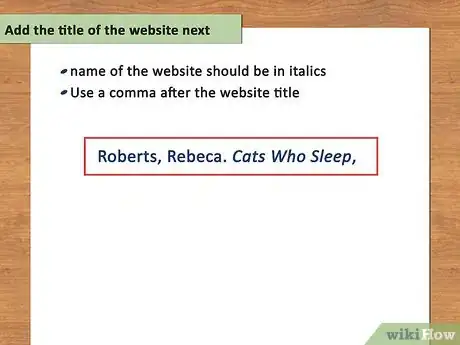
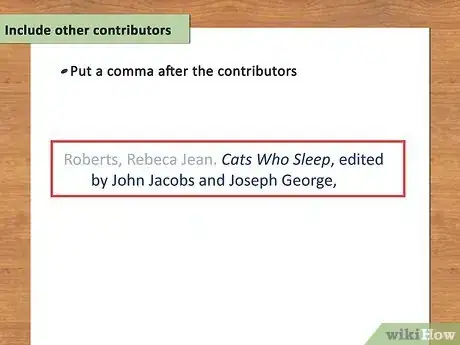

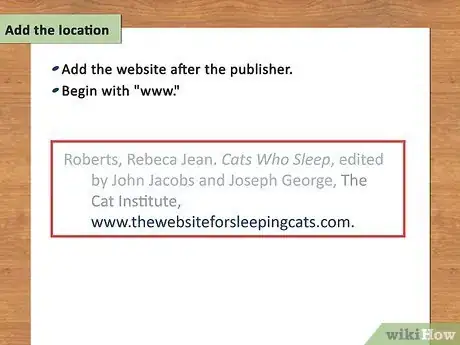
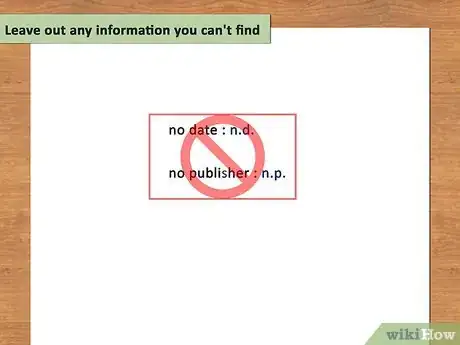
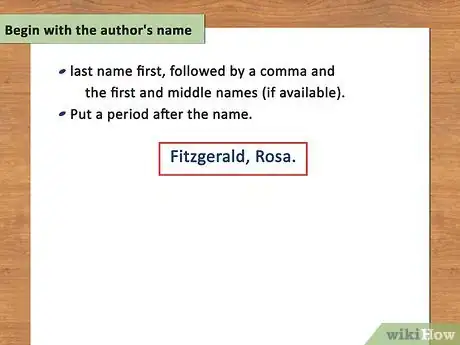


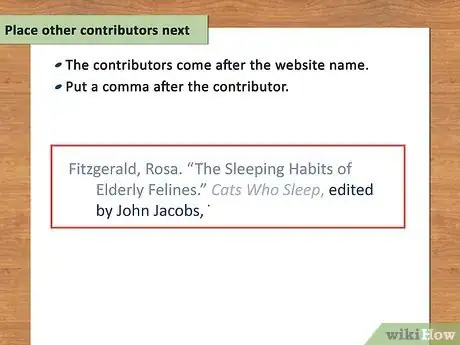

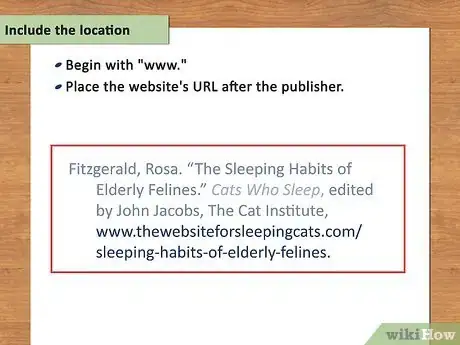
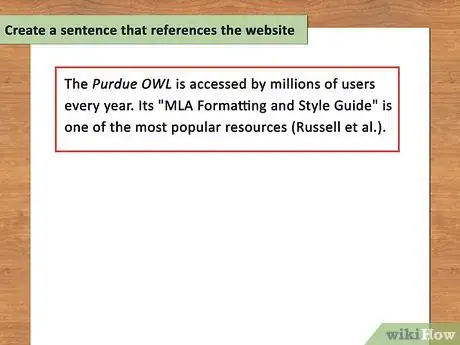
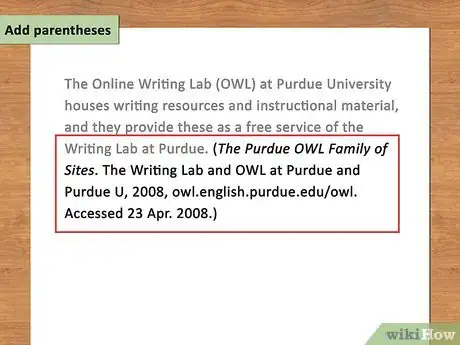




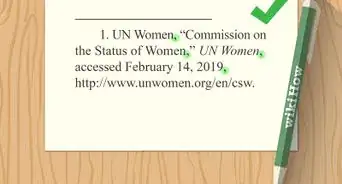

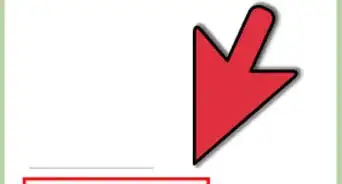

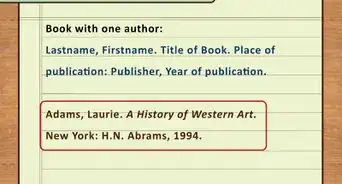


-Step-18.webp)

